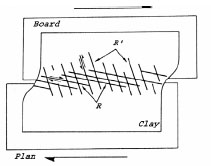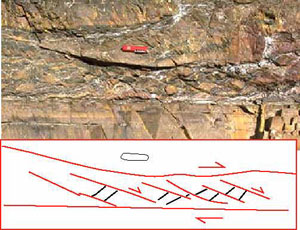| |||||||
|
|
|||||||
|
|
|||||||
| Riedel Shear | |||||||
|
Riedel shear refers to shear zones that consist of two sets of faults initially produced in experiments. Two dominant sets have opposite senses of shear and intersect each other initially at a high angle (Figure 1 and Figure 2). Riedel (1929) first carried out experiments by placing a thin clay layer over two rigid boards. When the two boards are sheared, two en-échelon sets of faults are observed on the overlying clay layer. These two sets incline at an angle to the underlying shear direction, intersect each other at a high angle, and have opposite sense of shear. Riedel shear is commonly believed to be the analog to an early stage of brittle deformation above two rigid basement blocks having strike-slip displacement. The geometry of the Riedel shear is effected by the material property and amount of strain (Katz et al, 2004). | |||||||
| Reference: |
|||||||
| Katz, Y., Weinberger, R., Aydin, A., 2004 Mandl, G., 1988 Riedel, W., 1929 |
|||||||
|
Readme | About Us | Acknowledgement | How to Cite | Terms of Use | Ⓒ Rock Fracture Knowledgebase |
|||||||

